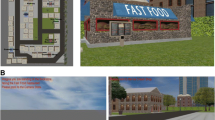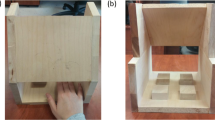Abstract
There is a significant overlap between the processes and neural substrates of spatial cognition and those subserving memory and learning. However, for procedural learning, which often is spatial in nature, we do not know how different forms of spatial knowledge, such as egocentric and allocentric frames of reference, are utilized nor whether these frames are differentially engaged during implicit and explicit processes. To address this issue, we trained human subjects on a movement sequence presented on a bi-dimensional (2D) geometric frame. We then systematically manipulated the geometric frame (allocentric) or the sequence of movements (egocentric) or both, and retested the subjects on their ability to transfer the sequence knowledge they had acquired in training and also determined whether the subjects had learned the sequence implicitly or explicitly. None of the subjects (implicit or explicit) showed evidence of transfer when both frames of reference were changed which suggests that spatial information is essential. Both implicit and explicit subjects transferred when the egocentric frame was maintained indicating that this representation is common to both processes. Finally, explicit subjects were also able to benefit from the allocentric frame in transfer, which suggests that explicit procedural knowledge may have two tiers comprising egocentric and allocentric representations.



Similar content being viewed by others
References
Aizenstein HJ, Stenger VA, Cochran J, Clark K, Johnson M, Nebes RD, Carter CS (2004) Regional brain activation during concurrent implicit and explicit sequence learning. Cereb Cortex 14:199–208
Bapi RS, Doya K, Harner AM (2000) Evidence for effector independent and dependent representations and their differential time course of acquisition during motor sequence learning. Exp Brain Res 132:149–162
Bapi RS, Miyapuram KP, Graydon FX, Doya K (2006) fMRI investigation of cortical and subcortical networks in the learning of abstract and effector-specific representations of motor sequences. Neuroimage 32:714–727
Bischoff-Grethe A, Goedert KM, Willingham DT, Grafton ST (2004) Neural substrates of response-based sequence learning using fMRI. J Cogn Neurosci 16:127–138
Bohbot VD, Iaria G, Petrides M (2004) Hippocampal function and spatial memory: evidence from functional neuroimaging in healthy participants and performance of patients with medial temporal lobe resections. Neuropsychology 18:418–425
Christie MA, Dalrymple-Alford JC (2004) A new rat model of the human serial reaction time task: contrasting effects of caudate and hippocampal lesions. J Neurosci 24:1034–1039
Cohen A, Ivry R, Keele SW (1990) Attention and structure in sequence learning. J Exp Psychol Learn Mem Cogn 16:17–30
Destrebecqz A, Cleeremans A (2001) Can sequence learning be implicit? New evidence with the process dissociation procedure. Psychon Bull Rev 8:343–350
Destrebecqz A, Peigneux P, Laureys S, Degueldre C, Del Fiore G, Aerts J, Luxen A, Van Der Linden M, Cleeremans A, Maquet P (2005) The neural correlates of implicit and explicit sequence learning: interacting networks revealed by the process dissociation procedure. Learn Mem 12:480–490
Doyon J, Owen AM, Petrides M, Sziklas V, Evans AC (1996) Functional anatomy of visuomotor skill learning in human subjects examined with positron emission tomography. Eur J Neurosci 8:637–648
Feigenbaum JD, Morris RG (2004) Allocentric versus egocentric spatial memory after unilateral temporal lobectomy in humans. Neuropsychology 18:462–472
Grafton ST, Salidis J, Willingham DB (2001) Motor learning of compatible and incompatible visuomotor maps. J Cogn Neurosci 13:217–231
Harrison LM, Duggins A, Friston KJ (2006) Encoding uncertainty in the hippocampus. Neural Netw 19:535–546
Hartley T, Maguire EA, Spiers HJ, Burgess N (2003) The well-worn route and the path less traveled: distinct neural bases of route following and wayfinding in humans. Neuron 37:877–888
Holdstock JS, Mayes AR, Cezayirli E, Aggleton JP, Roberts N (1999) A comparison of egocentric and allocentric spatial memory in medial temporal lobe and Korsakoff amnesics. Cortex 35:479–501
Jimenez L, Mendez C (2001) Implicit sequence learning with competing explicit cues. Q J Exp Psychol A 54:345–369
Mayr U (1996) Spatial attention and implicit sequence learning: evidence for independent learning of spatial and nonspatial sequences. J Exp Psychol Learn Mem Cogn 22:350–364
Moscovitch M, Rosenbaum RS, Gilboa A, Addis DR, Westmacott R, Grady C, McAndrews MP, Levine B, Black S, Winocur G, Nadel L (2005) Functional neuroanatomy of remote episodic, semantic and spatial memory: a unified account based on multiple trace theory. J Anat 207:35–66
Moscovitch M, Nadel L, Winocur G, Gilboa A, Rosenbaum RS (2006) The cognitive neuroscience of remote episodic, semantic and spatial memory. Curr Opin Neurobiol 16:179–190
Nadel L, Hardt O (2004) The spatial brain. Neuropsychology 18:473–476
Nissen MJ, Bullemer P (1987) Attentional requirements of learning: evidence from performance measures. Cogn Psychol 19:1–32
O’Keefe J (1976) Place units in the hippocampus of the freely moving rat. Exp Neurol 51:78–109
O’Keefe J, Nadel L (1978) The hippocampus as a cognitive map. Clarendon Press, Oxford
Pascual-Leone A, Grafman J, Hallett M (1994) Modulation of cortical motor output maps during development of implicit and explicit knowledge (see comments). Science 263:1287–1289
Poldrack RA, Sabb FW, Foerde K, Tom SM, Asarnow RF, Bookheimer SY, Knowlton BJ (2005) The neural correlates of motor skill automaticity. J Neurosci 25:5356–5364
Russeler J, Rosler F (2000) Implicit and explicit learning of event sequences: evidence for distinct coding of perceptual and motor representations. Acta Psychol (Amst) 104:45–67
Schendan HE, Searl MM, Melrose RJ, Stern CE (2003) An FMRI study of the role of the medial temporal lobe in implicit and explicit sequence learning. Neuron 37:1013–1025
Seidler RD, Purushotham A, Kim SG, Ugurbil K, Willingham D, Ashe J (2005) Neural correlates of encoding and expression in implicit sequence learning. Exp Brain Res 165:114–124
Shelton AL, Gabrieli JD (2004) Neural correlates of individual differences in spatial learning strategies. Neuropsychology 18:442–449
Strangman G, Heindel WC, Anderson JA, Sutton JP (2005) Learning motor sequences with and without knowledge of governing rules. Neurorehabil Neural Repair 19:93–114
Thorndyke PW, Hayes-Roth B (1982) Differences in spatial knowledge acquired from maps and navigation. Cognit Psychol 14:560–589
Tubau E, Lopez-Moliner J (2004) Spatial interference and response control in sequence learning: the role of explicit knowledge. Psychol Res 68:55–63
Willingham DB (1999) Implicit motor sequence learning is not purely perceptual. Mem Cognit 27:561–572
Willingham D, Goedert-Eschmann K (1999) The relation between implicit and explicit learning: evidence for parallel development. Psychol Sci 10:531–534
Willingham DB, Nissen MJ, Bullemer P (1989) On the development of procedural knowledge. J Exp Psychol Learn Mem Cogn 15:1047–1060
Willingham DB, Wells LA, Farrell JM, Stemwedel ME (2000) Implicit motor sequence learning is represented in response locations. Mem Cognit 28:366–375
Willingham DB, Salidis J, Gabrieli JD (2002) Direct comparison of neural systems mediating conscious and unconscious skill learning. J Neurophysiol 88:1451–1460
Acknowledgments
This study was supported by NIH grant NS40106 and Brain Sciences Chair, Department of Veterans Affairs.
Author information
Authors and Affiliations
Corresponding author
Rights and permissions
About this article
Cite this article
Liu, T., Lungu, O.V., Waechter, T. et al. Frames of reference during implicit and explicit learning. Exp Brain Res 180, 273–280 (2007). https://doi.org/10.1007/s00221-007-0853-z
Received:
Accepted:
Published:
Issue Date:
DOI: https://doi.org/10.1007/s00221-007-0853-z




